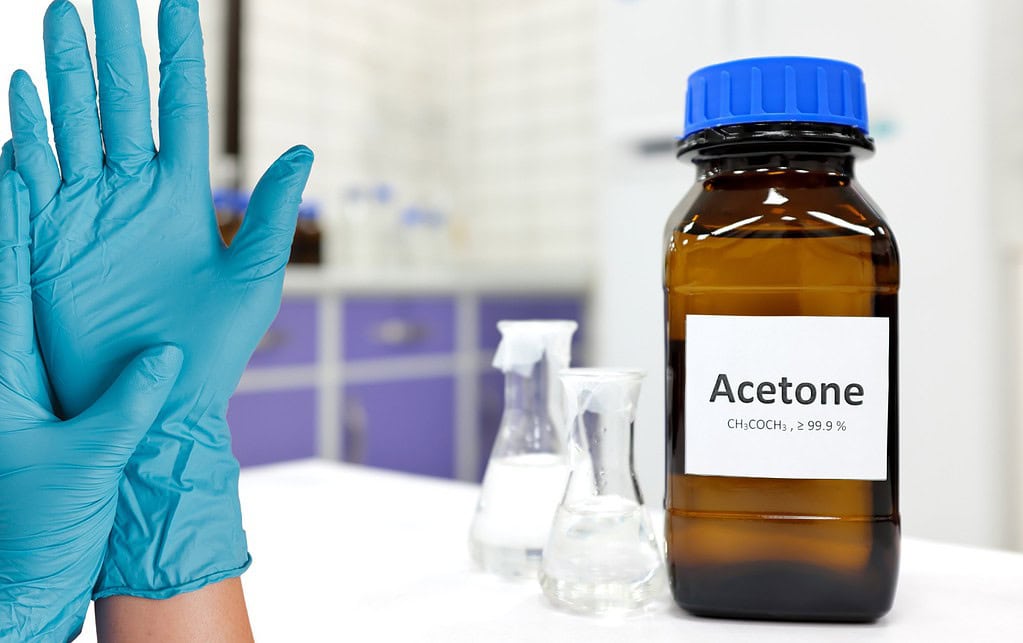Acetone is a clear, flammable liquid often used as a solvent in many industrial and household products, like nail polish removers and paint thinners.
Table of Contents
- Nitrile Gloves and Acetone Permeation
- Measurement Methods
- Standardized Test Methods
- Breakthrough Time and Permeation Rate
- Factors Influencing Permeation
- Chemical Properties of Acetone
- Material Properties
- Thickness and Porosity
- Temperature and Environmental Conditions
- Impact of Factors on Permeation Rate
- Temperature Effects
- Glove Quality and Thickness
- Exposure Duration and Concentration
- Mechanical Stress and Movement
- Related Posts
Although acetone can be useful, it also poses certain hazards. This substance is highly flammable and can cause irritation to the eyes, nose, and skin. Long-term exposure can lead to damage to the skin or respiratory problems. Inhalation of high concentrations can cause dizziness, headaches, or even central nervous system depression. Proper ventilation, protective equipment, and storage away from heat sources mitigate these risks effectively.

Handle acetone with nitrile gloves as it can irritate the skin and can degrade gloves made of latex or vinyl. Nitrile gloves provide excellent chemical resistance, ensuring that your skin is protected from acetone’s irritating and potentially harmful effects. The durability of nitrile also makes it suitable for prolonged exposure to solvents, preventing dermal damage and maintaining safety during its use. Proper glove selection is essential for minimizing health risks associated with handling acetone.
Nitrile Gloves and Acetone Permeation
Permeation of acetone through nitrile gloves is a critical consideration in assessing the protective capabilities of these gloves. Tests like ASTM F739-12 are important for measuring how long it takes for acetone to break through a material and the rate at which it permeates. Different factors like temperature, glove thickness, exposure time, and mechanical stress affect how fast acetone goes through nitrile gloves. Understanding these factors is crucial for selecting the appropriate gloves to ensure effective protection against chemical exposure.
Measurement Methods
Standardized Test Methods
Before assessing the permeation rate of acetone through nitrile gloves, standardized test methods like ASTM F739-12 are utilized. The test data provides information about the time it takes for a breakthrough and the rate at which gloves allow substances to pass through under controlled conditions.
Breakthrough Time and Permeation Rate
Test results indicate that nitrile gloves exhibit varying breakthrough times and permeation rates when exposed to different chemicals like acetone. For instance, the breakthrough time for nitrile gloves with acetone was found to be approximately 2.8 minutes, with fairly high permeation rates. These findings contribute crucial data to understanding the effectiveness of gloves in protecting against chemical exposure.
Permeation rates through nitrile gloves are influenced by a multitude of factors, including the composition of the challenge solution, such as the weight percentage of acetone, which significantly impacts the rate. Other factors like liquid molar volume, octanol-water partition coefficient, dipole moment, and strength also play a role. By analyzing these factors, we can gain a comprehensive understanding of how acetone permeates through nitrile gloves and how to enhance protection against chemical exposure.
Factors Influencing Permeation
Little factors can greatly influence the permeation rate of acetone through nitrile gloves. These factors include the chemical properties of acetone, the material properties of the gloves, and the testing conditions in which the permeation rate is measured. After considering all these factors, it becomes clear that a comprehensive understanding of each is crucial in evaluating the effectiveness of nitrile gloves in protecting against acetone exposure.
Chemical Properties of Acetone
Factors such as the molecular size, polarity, and solubility of acetone play a significant role in its permeation through nitrile gloves. Understanding these chemical properties is vital in assessing the effectiveness of gloves in providing protection against acetone exposure.
Material Properties
Influencing the permeation rate, the composition, thickness, and porosity of nitrile glove material are crucial factors that determine its resistance to acetone permeation. It is important to select gloves with appropriate material properties to ensure effective protection against acetone exposure.
It is vital to consider the relative acrylonitrile content as a key component influencing the chemical resistance of nitrile gloves. Thicker gloves typically provide better resistance to permeation, while lower porosity can also enhance the glove’s ability to resist acetone permeation.
Thickness and Porosity
Porosity is a key aspect of glove material properties that can influence the permeation of acetone. Lower porosity levels may lead to improved resistance to acetone permeation. Glove thickness also plays a significant role in determining the breakthrough time and steady-state permeation rate of acetone through nitrile gloves.
Acetone permeation may be influenced by the porosity of the nitrile glove material. Lower porosity levels could enhance the resistance of gloves to acetone permeation. Additionally, thicker gloves generally provide better resistance to permeation, which is an important factor to consider when selecting gloves for protection against acetone exposure.
Temperature and Environmental Conditions
The permeation rate of acetone through nitrile gloves can be influenced by various environmental factors. The table below outlines how temperature and environmental conditions impact the permeation rate of acetone through gloves.
| Temperature | Impact on Permeation Rate |
| Higher temperatures | Decrease breakthrough time and increase steady-state permeation rate |
The temperature and environmental conditions can significantly affect the permeation rate of acetone through nitrile gloves. Higher temperatures tend to decrease the breakthrough time and increase the steady-state permeation rate, emphasizing the importance of considering these factors in assessing the efficacy of glove protection against chemical exposure.
Impact of Factors on Permeation Rate
Temperature Effects
Impact of Temperature on Permeation Rate
| Temperature | Effect |
| 23°C | 36% increase in acetone steady-state permeation rate through nitrile gloves |
Glove Quality and Thickness
Thicker, higher quality nitrile gloves provide better resistance to acetone permeation. The thickness and quality of the gloves play a crucial role in determining their effectiveness in protecting against chemical exposure.
Exposure Duration and Concentration
Prolonged exposure and higher concentrations of acetone can compromise the integrity of nitrile gloves over time. It is important to consider the duration and concentration of acetone exposure when selecting nitrile gloves for protection.
Mechanical Stress and Movement
Simulated whole-glove movement significantly shortens breakthrough time, increases the steady-state permeation rate, and increases cumulative permeation of acetone through nitrile gloves. Mechanical stress and movement can impact the effectiveness of gloves in providing protection against acetone exposure.
Now, it is evident that the permeation rate of acetone through nitrile gloves is crucial in assessing their effectiveness in protecting against chemical exposure. Measurement methods like ASTM standards and factors such as temperature, glove thickness/quality, exposure duration/concentration, and mechanical stress play vital roles in influencing the permeation rate. Understanding these factors is necessary for selecting appropriate gloves and ensuring adequate protection against acetone exposure.






